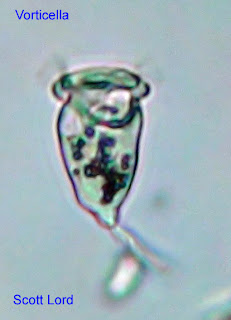D.J. Patterson, Free-living Freshwater Protozoa A Colour Guide. 1996 Manson Publishing Ltd.
Douglass Grant Smith, Pennak's Freshwater Invertebrates of the United States Fourth Edition, Porifera to Crustacea. 2001 John Wiley and Sons Inc.
Tuesday, November 15, 2011
Friday, November 11, 2011
Final Observation
Today I observed my MicroAquarium for the last time. The organisms in the aquarium have increased again, most of them are still towards the top of the tank feeding. The plants show definite signs of being eaten, and there is plant and dirt debris all over the place throughout the aquarium. Towards the bottom of the aquarium several more of the same fungi have appeared and many dead organisms can be seen barely sticking out of the dirt. It looks like new plants of the same type already in the aquarium have started to grow out of the dirt on the bottom. An Ostracoda (seed shrimp) which i had found earlier in the week has grown about twice the size it was when i first saw it. Ostracoda move around by means of beating movements of the first and second antennae, and feed mostly on bacteria, molds, and algae (Smith 2001). While watching this little guy, he was moving rapidly all around the aquarium, and feeding often. I couldn't locate any new organisms but the ones that I've been seeing have increased in great number.
Tuesday, November 8, 2011
Third Observation
I observed my MicroAquarium November 4th and it was teaming with action. The organisms are moving around quite a bit at the top, feeding from the plant parts and mosses, and collecting organic matter. There are many stationary organisms as well around the middle and bottom of the aquarium. The number of organisms have increased many times over, and I've found a few new organisms roaming around.
Here is a picture of a Vorticella, they are small unicellular protists that move around using a long hair like cilia (Patterson 1996). These were hanging out around the bottom of the aquarium and collecting bits of organic matter.
I only found a couple of these Arcella around the bottom of the aquarium. Arcella are a type of amoeba that move around with finger like structures called pseudopods and feed on unicellular green algae or small protozoa (Patterson 1996). I actually saw one munching on a diatom but couldn't get a good picture of it.
Here's a picture of a Diatom, There were several of these unicellular organisms all throughout the aquarium. They are non-motile, and Diatoms have chlorophyll which use energy to make food for themselves (Patterson 1996).
Here is a picture of a Vorticella, they are small unicellular protists that move around using a long hair like cilia (Patterson 1996). These were hanging out around the bottom of the aquarium and collecting bits of organic matter.
I only found a couple of these Arcella around the bottom of the aquarium. Arcella are a type of amoeba that move around with finger like structures called pseudopods and feed on unicellular green algae or small protozoa (Patterson 1996). I actually saw one munching on a diatom but couldn't get a good picture of it.
Here's a picture of a Diatom, There were several of these unicellular organisms all throughout the aquarium. They are non-motile, and Diatoms have chlorophyll which use energy to make food for themselves (Patterson 1996).
Subscribe to:
Comments (Atom)



